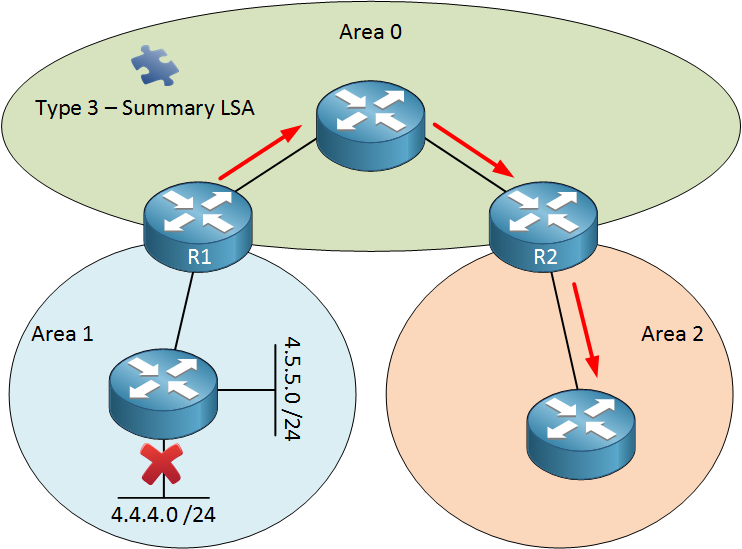If you are studying OSPF you will learn that OSPF uses LSA type 3 for inter-area routers and LSA type 5 for external prefixes that are redistributed into OSPF.
OSPF can do summarization, but it’s impossible to summarize within an area. This means we have to configure summarization on an ABR or ASBR. OSPF can only summarize our LSA types 3 and 5.
If you want summarization for OSPF, you will have to configure it yourself. I will show you how to do this for inter-area and external prefixes. Let’s start with an example:

Look at the topology above. If we don’t use summarization (which is the default), there will be an LSA for every specific prefix. If we have a link failure in area 1, then R1 (our ABR) will flood a new type 3 summary LSA, and this change has to be propagated throughout all our OSPF areas. Since the LSDB will change our OSPF routers, they will have to re-run the SPF algorithm, which takes time and CPU power.
If we use summarization, things will be different. I can create a summary on R1 to summarize the different type 3 summary LSAs. Instead of sending an LSA for 4.4.4.0 /24 and 4.5.5.0 /24, I could send 4.0.0.0 /8 or something alike.
If a link failure occurs in area 1, nothing will change for area 0 and area 2 since they don’t have the specific 4.4.4.0 /24 prefix in their LSDB but the 4.0.0.0 /8 summary. Nothing will change in their LSDB, so we don’t have to re-run the SPF algorithm.
Summarization of type 3 summary LSAs means we are creating a summary of all the interarea routes. This is why we call it interarea route summarization. There are a couple of things to be aware of:
- A summary route will only be advertised if you have at least one subnet that falls within the summary range.
- A summary route will have the cost of the subnet with the lowest cost that falls within the summary range.
- Your ABR that creates the summary route will create a null0 interface to prevent loops.
- OSPF is a classless routing protocol, so you can pick any subnet mask you like for prefixes.
If you look at my picture, you can see that 4.4.4.0 /24 and 4.5.5.0 /24 both fall within the 4.0.0.0 /8 summary. We will still advertise the summary if we have a link failure for the 4.4.4.0 /24 prefix. If 4.5.5.0 /24 fails as well, then the summary will be withdrawn since no subnet is left within the 4.0.0.0 /8 range.
Enough theory. Let’s take a look at the configuration of inter-area summarization. This is the topology we’ll use:

I’m going to show you an example of interarea route summarization. I’m going to use routers R1 and R2. R1 will have 4 loopback interfaces which are in area 0. The link between R1 and R2 is in area 1, which turns R1 into an ABR that can do summarization.


Thanks a ton to clear summarisation of LSA type 3 and LSA type 5 so easily…The website has been helping a lot in my learning in CCNP R&S.
I am indebted to you…
Hi Rene,
I want to ask for summarisation on ospf.
If we do a summary and one router behind router Donna down, how the other routers know that one router is down and change their LSDB so do not send ip packet to it?
Whether OSPF not have or work lika a Split-horizon on RIP ??
Thanks
Ael Irsal
Hi Ael,
Split Horizon is only for distance vector based routing protocols like RIP and EIGRP. OSPF doesn’t need this as routers within the area know what the topology looks like…the LSDB is synchronized.
When a router goes down, the neighbor adjacency will be removed and as a result LSAs will be removed and SPF will be re-run.
I have spend thousand of dollars training on my CCNA and CCNP and different instructors teaching but the way you explain with small lab and verification has help me to learn and clarify doubts I had.
It’s nice you keep this chapters short. You were born to teach.
Thanks
Hi Alfredo,
Thanks for your kind words, I’m really glad to hear that my material is so helpful to you!
Rene